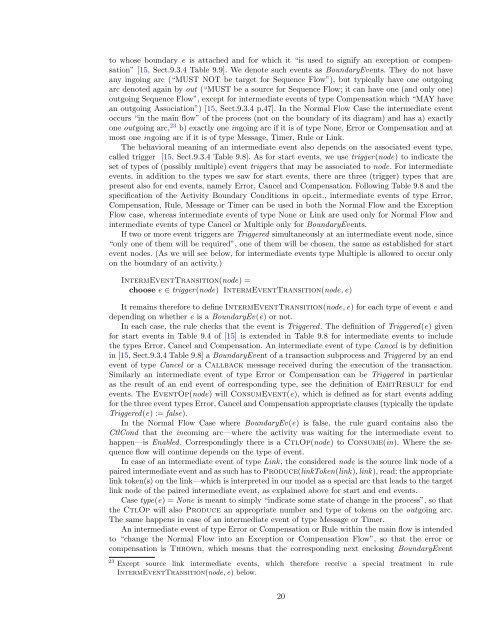BPMN and Beyond Business process modelling notation, workflow ...
BPMN and Beyond Business process modelling notation, workflow ...
BPMN and Beyond Business process modelling notation, workflow ...
Create successful ePaper yourself
Turn your PDF publications into a flip-book with our unique Google optimized e-Paper software.
to whose boundary e is attached <strong>and</strong> for which it “is used to signify an exception or compensation”<br />
[15, Sect.9.3.4 Table 9.9]. We denote such events as BoundaryEvents. They do not have<br />
any ingoing arc (“MUST NOT be target for Sequence Flow”), but typically have one outgoing<br />
arc denoted again by out (“MUST be a source for Sequence Flow; it can have one (<strong>and</strong> only one)<br />
outgoing Sequence Flow”, except for intermediate events of type Compensation which “MAY have<br />
an outgoing Association”) [15, Sect.9.3.4 p.47]. In the Normal Flow Case the intermediate event<br />
occurs “in the main flow” of the <strong>process</strong> (not on the boundary of its diagram) <strong>and</strong> has a) exactly<br />
one outgoing arc, 23 b) exactly one ingoing arc if it is of type None, Error or Compensation <strong>and</strong> at<br />
most one ingoing arc if it is of type Message, Timer, Rule or Link.<br />
The behavioral meaning of an intermediate event also depends on the associated event type,<br />
called trigger [15, Sect.9.3.4 Table 9.8]. As for start events, we use trigger(node) to indicate the<br />
set of types of (possibly multiple) event triggers that may be associated to node. For intermediate<br />
events, in addition to the types we saw for start events, there are three (trigger) types that are<br />
present also for end events, namely Error, Cancel <strong>and</strong> Compensation. Following Table 9.8 <strong>and</strong> the<br />
specification of the Activity Boundary Conditions in op.cit., intermediate events of type Error,<br />
Compensation, Rule, Message or Timer can be used in both the Normal Flow <strong>and</strong> the Exception<br />
Flow case, whereas intermediate events of type None or Link are used only for Normal Flow <strong>and</strong><br />
intermediate events of type Cancel or Multiple only for BoundaryEvents.<br />
If two or more event triggers are Triggered simultaneously at an intermediate event node, since<br />
“only one of them will be required”, one of them will be chosen, the same as established for start<br />
event nodes. (As we will see below, for intermediate events type Multiple is allowed to occur only<br />
on the boundary of an activity.)<br />
IntermEventTransition(node) =<br />
choose e ∈ trigger(node) IntermEventTransition(node, e)<br />
It remains therefore to define IntermEventTransition(node, e) for each type of event e <strong>and</strong><br />
depending on whether e is a BoundaryEv(e) or not.<br />
In each case, the rule checks that the event is Triggered. The definition of Triggered(e) given<br />
for start events in Table 9.4 of [15] is extended in Table 9.8 for intermediate events to include<br />
the types Error, Cancel <strong>and</strong> Compensation. An intermediate event of type Cancel is by definition<br />
in [15, Sect.9.3.4 Table 9.8] a BoundaryEvent of a transaction sub<strong>process</strong> <strong>and</strong> Triggered by an end<br />
event of type Cancel or a Callback message received during the execution of the transaction.<br />
Similarly an intermediate event of type Error or Compensation can be Triggered in particular<br />
as the result of an end event of corresponding type, see the definition of EmitResult for end<br />
events. The EventOp(node) will ConsumEvent(e), which is defined as for start events adding<br />
for the three event types Error, Cancel <strong>and</strong> Compensation appropriate clauses (typically the update<br />
Triggered(e) := false).<br />
In the Normal Flow Case where BoundaryEv(e) is false, the rule guard contains also the<br />
CtlCond that the incoming arc—where the activity was waiting for the intermediate event to<br />
happen—is Enabled. Correspondingly there is a CtlOp(node) to Consume(in). Where the sequence<br />
flow will continue depends on the type of event.<br />
In case of an intermediate event of type Link, the considered node is the source link node of a<br />
paired intermediate event <strong>and</strong> as such has to Produce(linkToken(link), link), read: the appropriate<br />
link token(s) on the link—which is interpreted in our model as a special arc that leads to the target<br />
link node of the paired intermediate event, as explained above for start <strong>and</strong> end events.<br />
Case type(e) = None is meant to simply “indicate some state of change in the <strong>process</strong>”, so that<br />
the CtlOp will also Produce an appropriate number <strong>and</strong> type of tokens on the outgoing arc.<br />
The same happens in case of an intermediate event of type Message or Timer.<br />
An intermediate event of type Error or Compensation or Rule within the main flow is intended<br />
to “change the Normal Flow into an Exception or Compensation Flow”, so that the error or<br />
compensation is Thrown, which means that the corresponding next enclosing BoundaryEvent<br />
23 Except source link intermediate events, which therefore receive a special treatment in rule<br />
IntermEventTransition(node, e) below.<br />
20
















